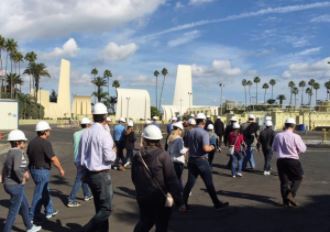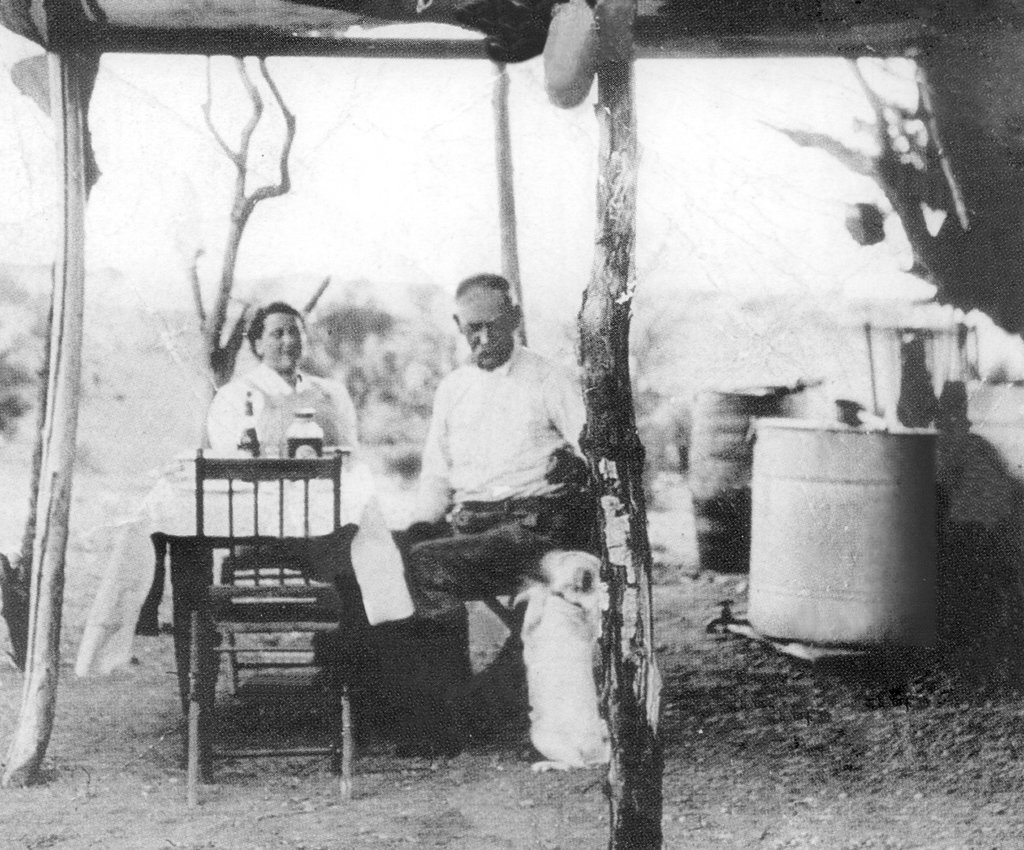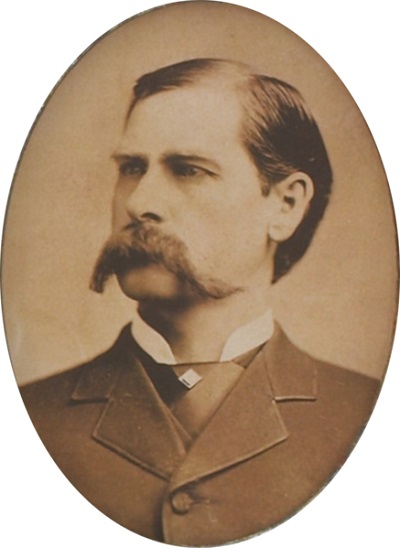This Week in Petroleum History, Feb. 24 – March 2
February 24, 1938 – First Nylon Bristle Toothbrush –
The Weco Products Company of Chicago, Illinois, “Dr. West’s Miracle-Tuft” toothbrush went on sale – the first to use synthetic nylon developed three years earlier by a former Harvard professor working at a DuPont research laboratory in New Jersey.
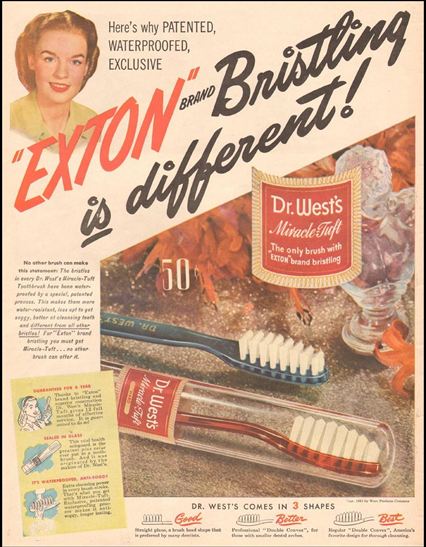
August 1938 Life magazine advertisement for first nylon bristle toothbrush.
“Until now, all good toothbrushes were made with animal bristles,” noted a 1938 Weco Products advertisement in Life magazine. “Today, Dr. West’s new Miracle-Tuft is a single exception. It is made with EXTON, a unique bristle-like filament developed by the great DuPont laboratories, and produced exclusively for Dr. West’s.”
Guaranteed for “no bristle shedding,” and selling for 50 cents ($10.96 in 2025 dollars), the toothbrush became the first commercial use of nylon.
February 25, 1918 – Pawnee Bill’s Oklahoma Oil Companies
As World War I neared its end, Gordon William “Pawnee Bill” Lillie entered the oil business in Yale, Oklahoma. Despite not being as famous as his Wyoming friend Col. William F. “Buffalo Bill” Cody, Lillie was a widely known showman and promoter of his state.
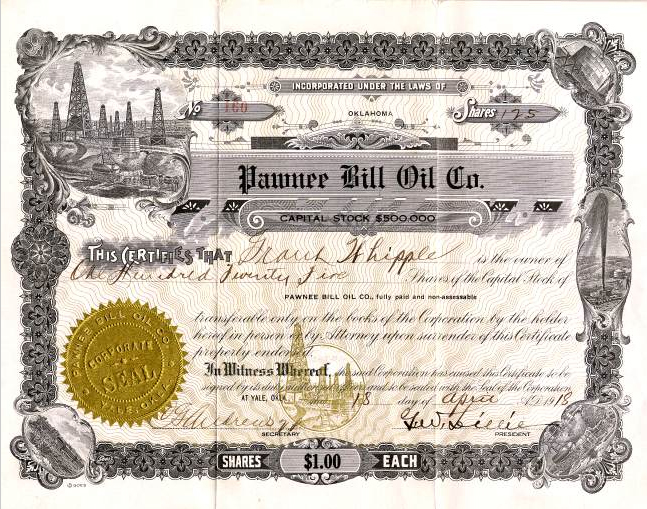
Although most are only family keepsakes, some old oil company certificates are valued by collectors.
During World War I, the Pawnee Bill Oil Company operated a refinery in Yale and leased 25 railroad tank cars. After the war, reduced demand for refined petroleum products, forced the company to operate at half capacity as other Oklahoma refineries began closing.
Although his oil exploration company remained, Pawnee Bill had to shut down his Yale refinery in March 1921. A decade earlier, friend and fellow western showman Col. William Cody had unsuccessfully searched for Wyoming oil (see Shoshone Oil Company).
Learn more in Pawnee Bill Oil Company.
February 25, 1919 – Oregon enacts First Gasoline Tax
Oil was selling for just $2 a barrel when Oregon enacted the one-cent gas tax to be used for road construction and maintenance. It was the first U.S. state to impose a gasoline tax. Less than two months later, Colorado and New Mexico followed Oregon’s example.
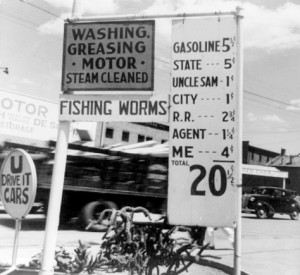
A circa 1930s service station owner explains why gas costs 20 cents a gallon in this Library of Congress photo.
By 1930, every state would add a gasoline tax of up to three cents per gallon. Faced with a $2.1 billion federal deficit, President Herbert Hoover tacked on another one-cent per gallon federal excise tax in 1932.

National average tax rates have remained steady with gasoline taxes increasing in seven states and decreasing in six, according to the Department of Energy.
In August 2024, federal taxes included excises taxes of 18.4 cents per gallon on gasoline and 24.3 cents per gallon on diesel fuel, according to the Energy Information Administration (EIA). State-imposed gasoline taxes have varied from a low of 8.9 cents per gallon (Alaska) to a high 69.8 cents per gallon (California). The federal tax of has not changed since 1993.
February 25, 1926 – Wyatt Earp’s California Oil Wells
A Kern County, California, oil well invested in by former lawman Wyatt Earp began producing 150 barrels of oil a day, confirming his belief in the field five miles north of Bakersfield. As early as 1901, drilling by the Shasta Oil Company had stirred local excitement, but the company went bust after three dry holes. In July 1924, Getty Oil Company began drilling on the Earp lease.
“Old Property Believed Worthless for Years West of Kern Field Relocated by Old-Timer,” declared the San Francisco Examiner, describing Earp, 75, as the “pioneer mining man of Tombstone.” The newspaper also reported, “Indications are that a great lake of oil lies beneath the surface in this territory.”
Working on his memoirs, Earp turned over management of his oil properties to his sister-in-law, and his wife noted, “I was in hopes they would bring in a two or three hundred barrel well. But I must be satisfied as it could have been a duster, too.”
Learn more in Wyatt Earp’s California Oil Wells.
February 27, 1925 – Congress passes Osage Indians Act
As a result of murders and a “reign of terror” in the Osage Nation, the U.S. Congress passed the Osage Indians Act of 1925, prohibiting non-Osages from inheriting headrights of tribal members possessing more than one-half Osage blood. The Osage people’s sudden wealth from oil royalties (see Million Dollar Auctioneer) had brought criminal conspiracies to the Oklahoma Indian Reservation with dozens of Osage killed for the headrights to their land.
February 27, 1962 – California Voters approve Offshore Drilling
Voters in Long Beach, California, approved the “controlled exploration and exploitation of the oil and gas reserves” underlying their harbor south of Los Angeles. The city’s charter had prohibited drilling there since a 1956 referendum, but advances in technology offered new and environmentally sensitive opportunities to exploit an additional 6,500 acres of the Wilmington oilfield.
Four artificial islands were soon constructed at a cost of $22 million by a consortium of companies called THUMS: Texaco (now Chevron), Humble (now ExxonMobil), Union Oil (now Chevron), Mobil (now ExxonMobil) and Shell Oil. The islands in 1967 were named Grissom, White, Chaffee, and Freemen in honor of lost NASA astronauts. Occidental Petroleum purchased THUMS in 2000.
Eventually operated by the California Resources Corporation, the four “Astronaut Islands” are designed to appear to be occupied by upscale condominiums, thanks to Disneyland architect Joseph Linesch, whose integration of oil production structures the Los Angeles Times described as “part Disney, part Jetsons, part Swiss Family Robinson.”
Learn more in THUMS – California’s Hidden Oil Islands.
February 28, 1935 – DuPont Chemist invents Nylon
A former Harvard professor working in a DuPont research laboratory discovered the world’s first synthetic fiber, the petroleum product nylon. After experimenting with artificial materials for more than six years, professor Wallace Carothers created a long molecule chain — a stretching plastic. The inventor earlier discovered neoprene (commonly used in wetsuits).

Carbon, hydrogen and oxygen atoms strung in a chain create manmade fibers used for textiles and plastics. Each molecule contains six carbon atoms.
Carothers produced the fibers when he formed a polymer chain using a process to join individual molecules. Each molecule consisted of 100 or more repeating units of carbon, hydrogen and oxygen atoms, strung in a chain. DuPont patented nylon in 1935, but it was not revealed until 1938.
Originally called “Fiber 66,” the polyamide resulted from 12 years and $27 million in research. Several marketing names were considered for the “artificial silk,” before nylon was chosen. The first commercial use was for toothbrush bristles. After World War II, nylon hosiery for women would make a fortune for the Delaware chemical company.
Learn more in Nylon, a Petroleum Polymer.
February 28, 1982 – Getty Museum becomes Richest in World
Following years of legal battle by his relatives, the J. Paul Getty Museum in Los Angeles became the most richly endowed museum in the world after receiving a $1.2 billion bequest left to it by oil billionaire J. Paul Getty, who died in 1976.

The J. Paul Getty Museum opened in Los Angeles in 1954. The museum’s art collection today is housed at the Getty Center (above in 2009) and the Getty Villa on the Malibu coast.
After working in his father’s oilfields in Oklahoma, Getty founded his first oil company in Tulsa and drilled the Nancy Taylor No. 1 well near Haskell, where oil and natural gas production began in 1910. Getty’s oil wealth philanthropy also established the Getty Conservation Institute and the Getty Research Institute, according to the J. Paul Getty Trust.
March 1, 1921 – Halliburton improves Well Cementing
Erle P. Halliburton patented his “Method and Means for Cementing Oil Wells,” improving a key oilfield technology. “It is well known to those skilled in the art of oil well drilling that one of the greatest obstacles to successful development of oil bearing sands has been the encountering of liquid mud water and the like during and after the process of drilling the wells,” he noted in his patent application.
Halliburton’s well cementing process isolated downhole zones, guarded against collapse of the casing, and allowed control of the well, helping to protect the environment. His patent application noted that typical oil production, “hampered by water intrusion that required time and expense for pumping out…has caused the abandonment of many wells which would have developed a profitable output.”
In March 1949, Halliburton Oil Well Cementing Company and Stanolind Oil completed the first commercial application of hydraulic fracturing at a well near Duncan.
Learn more in Halliburton cements Wells.
March 2, 1922 – Lease sells for $1 Million in Osage Nation
Under the broad crown of a giant elm next to the Osage Council House in Pawhuska, Oklahoma, Skelly Oil and Phillips Petroleum Company jointly bid more than one million dollars for a 160-acre tract of land.

Colonel Elmer Ellsworth Walters (in the striped shirt) was famous as “auctioneer of the Osage Nation.”
The 1922 auction — Oklahoma’s first million dollar mineral lease — took place in the shade of what became known as the “Million Dollar Elm.” Independent producers such as Frank Phillips, Harry Sinclair, Bill Skelly, J. Paul Getty and E.W. Marland were frequent bidders for promising leases. The Osage would erect a statue of their auctioneer, Colonel Elmer Ellsworth Walters, in his hometown of Skedee.
Learn more in Million Dollar Elm.
_______________________
Recommended Reading: Enough for One Lifetime: Wallace Carothers, Inventor of Nylon (2005); Pawnee Bill: A Biography of Major Gordon W. Lillie (1958); Wyatt Earp: The Life Behind the Legend
(2012); Black Gold in California: The Story of California Petroleum Industry
(2016); Du Pont Dynasty: Behind the Nylon Curtain
(1984); The Great Getty: The Life and Loves of J. Paul Getty – Richest Man in the World
(1986); Erle P. Halliburton, Genius with Cement
(1959); The Osage Oil Boom
(1989). Your Amazon purchases benefit the American Oil & Gas Historical Society; as an Amazon Associate, AOGHS earns a commission from qualifying purchases.
_______________________
The American Oil & Gas Historical Society (AOGHS) preserves U.S. petroleum history. Please become an AOGHS annual supporter and help maintain this energy education website and expand historical research. For more information, contact bawells@aoghs.org. Copyright © 2025 Bruce A. Wells. All rights reserved.



